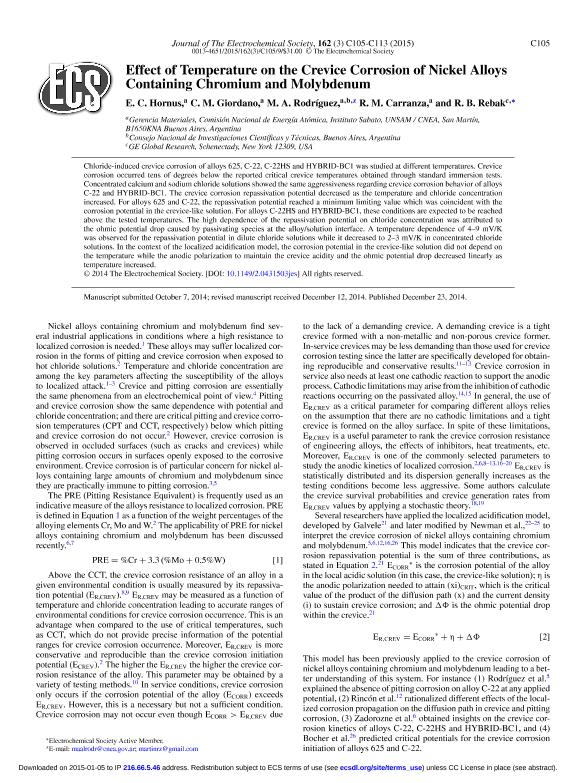Artículo
Effect of temperature on the crevice corrosion of nickel alloys containing chromium and molybdenum
Hornus, Edgar Cristian; Giordano, Claudia Marcela ; Rodríguez, Martín Alejandro
; Rodríguez, Martín Alejandro ; Rebak, Raul Basilio
; Rebak, Raul Basilio
 ; Rodríguez, Martín Alejandro
; Rodríguez, Martín Alejandro ; Rebak, Raul Basilio
; Rebak, Raul Basilio
Fecha de publicación:
03/2015
Editorial:
Electrochemical Society
Revista:
Journal of the Electrochemical Society
ISSN:
0013-4651
Idioma:
Inglés
Tipo de recurso:
Artículo publicado
Clasificación temática:
Resumen
Chloride-induced crevice corrosion of alloys 625, C-22, C-22HS and HYBRID-BC1 was studied at different temperatures. Crevice corrosion occurred tens of degrees below the reported critical crevice temperatures obtained through standard immersion tests. Concentrated calcium and sodium chloride solutions showed the same aggressiveness regarding crevice corrosion behavior of alloys C-22 and HYBRID-BC1. The crevice corrosion repassivation potential decreased as the temperature and chloride concentration increased. For alloys 625 and C-22, the repassivation potential reached a minimum limiting value which was coincident with the corrosion potential in the crevice-like solution. For alloys C-22HS and HYBRID-BC1, these conditions are expected to be reached above the tested temperatures. The high dependence of the repassivation potential on chloride concentration was attributed to the ohmic potential drop caused by passivating species at the alloy/solution interface. A temperature dependence of 4-9 mV/K was observed for the repassivation potential in dilute chloride solutions while it decreased to 2-3 mV/K in concentrated chloride solutions. In the context of the localized acidification model, the corrosion potential in the crevice-like solution did not depend on the temperature while the anodic polarization to maintain the crevice acidity and the ohmic potential drop decreased linearly as temperature increased.
Palabras clave:
CREVICE CORROSION
,
TEMPERATURE
,
NICKEL ALLOYS
,
CHLORIDE
Archivos asociados
Licencia
Identificadores
Colecciones
Articulos(SEDE CENTRAL)
Articulos de SEDE CENTRAL
Articulos de SEDE CENTRAL
Citación
Hornus, Edgar Cristian; Giordano, Claudia Marcela; Rodríguez, Martín Alejandro; Rebak, Raul Basilio; Effect of temperature on the crevice corrosion of nickel alloys containing chromium and molybdenum; Electrochemical Society; Journal of the Electrochemical Society; 162; 3; 3-2015; C105-C113
Compartir
Altmétricas



